Journey of a River NCERT Solutions | Our Wondrous World Class 5 - New NCERT PDF Download
| Table of contents |

|
| Page No. 22 |

|
| Page No. 25 |

|
| Page No. 26 |

|
| Page No. 27 |

|
| Page No. 28 |

|
| Page No. 29 |

|
| Page No. 30 |

|
| Page No. 31 |

|
| Page No. 32 |

|
| Page No. 33 |

|
| Page No. 34 |

|
| Page No. 35 |

|
| Page No. 37 |

|
Page No. 22
Look at the image given below and answer the following.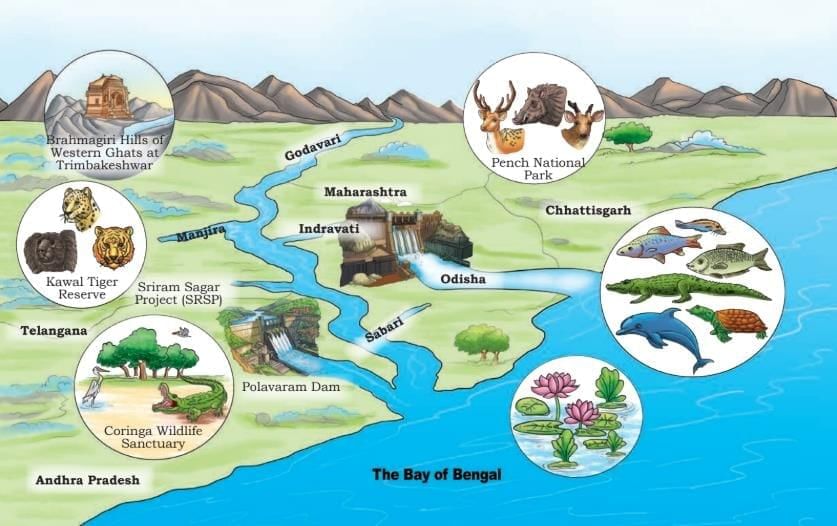
1. Name the states that Godavari flows through.
Answer: Maharashtra, Telangana, Chhattisgarh, Andhra Pradesh, Odisha.
2. Name a dam and a wildlife sanctuary along the length of Godavari.
Answer: Dam: Polavaram Dam (Andhra Pradesh), Sriram Sagar Project (SRSP, Telangana)
Wildlife Sanctuary: Kawal Tiger Reserve (Telangana), Coringa Wildlife Sanctuary (Andhra Pradesh)
3. Which other small rivers join Godavari in its journey?
Answer: Manjira, Indravati, Sabari.
Page No. 25
Q. List three ways in which people are dependent on the river Godavari.
Answer: 1. The river gives drinking water to people in towns and villages.
2. It provides water for growing crops in fields.
3. It helps people earn a livelihood through fishing, farming, and even ecotourism.
Q. In which occupations are people engaged near the river Godavari?
Answer: Farmers, fishermen, factory workers, boatmen, traders, and people working in ecotourism (like guides or in lodges).
Page No. 26
Q. Which crops do you see growing near the Godavari?
Answer: Mainly rice (paddy), sugarcane, and banana.
Q. Which crops grow in your region? Where does the water for irrigation come from?
Answer: (Sample answer—you fill your own): In my region, I see wheat and cotton growing. The water comes from a nearby river and canals.
Activity 1
Make a poster in your classroom showing all the ways rivers help people. Include drawings of homes, farms, boats, fishermen and more.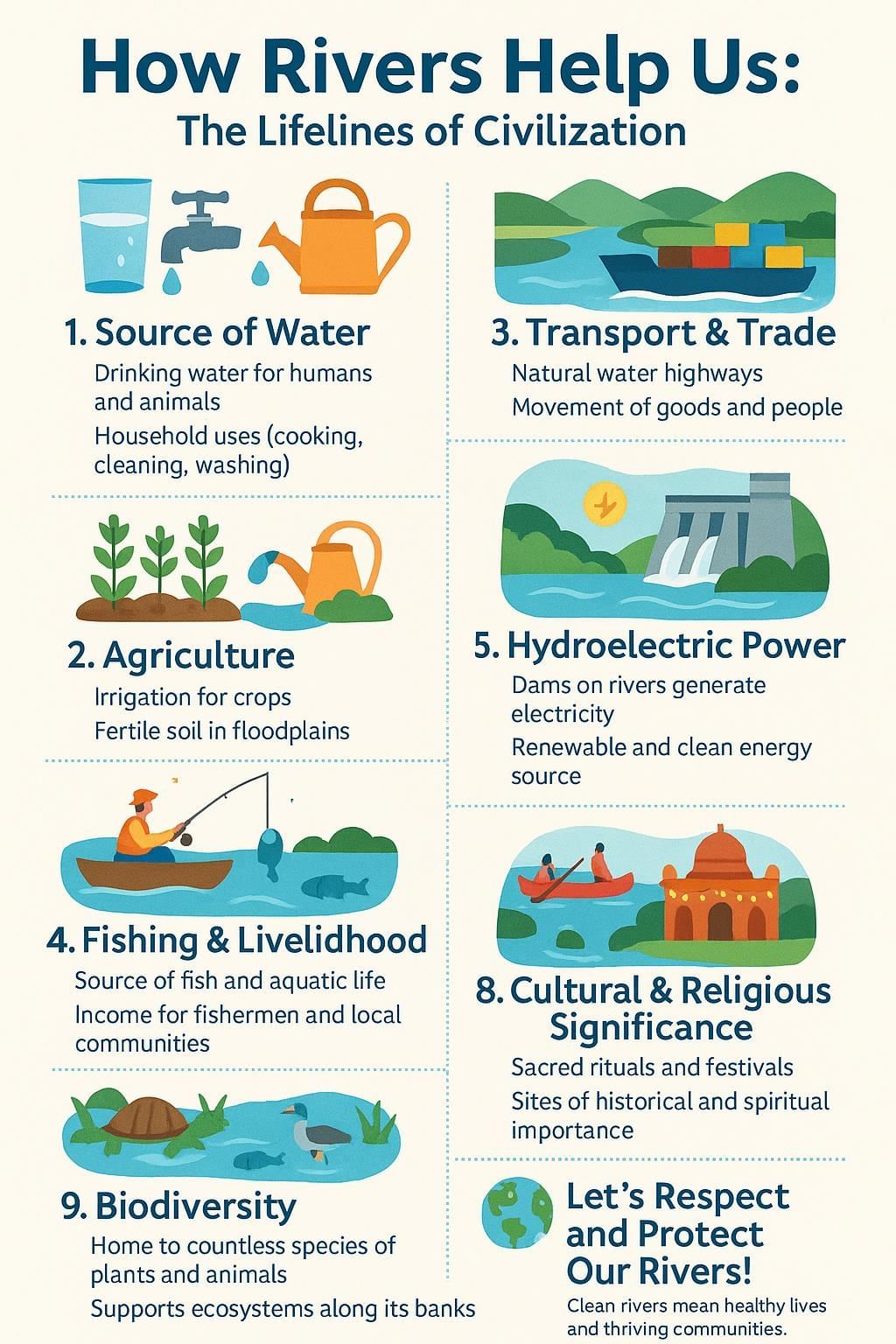
Page No. 27
Write
Q. What problems can arise after a dam is built? How can they be solved?
Problems:
- The land where people and animals live may get flooded.
- Forests and wildlife habitats are lost.
- People may have to shift homes.
Solutions:
- The government should help people find new places to live.
- Plant trees and create new homes for animals.
- Build dams only after proper study to reduce harm.
Page No. 28
Write
Q. Where do the plastic wrappers and bags that we litter end up?
Answer: They often reach rivers and water bodies, either by wind, rain, or through drains. This can pollute water and harm animals that live in and near water.
Q. What kinds of soaps, shampoos or floor cleaners are used in your home? Where does the unclean water go?
Answer: We use ready-made soaps, shampoos, and cleaners. The dirty water from cleaning goes down the drain. If it is not cleaned at a treatment plant, it may end up in rivers, harming their water quality and the life inside them.
Discuss
Q. Ask your parents or elders about the condition of water bodies near your home when they were your age. What is the status of those water bodies today?
Answer: Conduct the Interview: Ask your parents or elders specific questions about a named water body (e.g., “Ram Talab” near your home) from their childhood. Example questions:
- Was the water clean enough to see fish or plants?
- What animals or birds did you see?
- How was the water body used back then?
Visit or Research the Water Body: Observe its current state or gather information (e.g., through local knowledge or news). Note water clarity, presence of life, size, and usage.
Fill the Table (Example Format):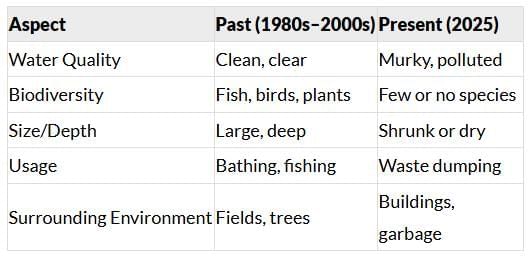
Analyse Changes: Discuss why the water body changed (e.g., pollution, urbanisation), linking to concepts like human impact on the environment.
Page No. 29
Activity 2
Q. List things thrown into the waste bin at home/school. If thrown into a river/pond, how would each harm animals/plants/people?
Answer: List of things:
- Plastic bags: Can choke and kill fish or birds.
- Food waste: Makes water dirty, attracts pests, and can rot.
- Broken glass: Can injure animals or people stepping on it.
- Old batteries: Release harmful chemicals, poisoning water and living things.
- Paper: Can dirty and block water flow.
- Clothes: Can tangle and trap fish or birds.
- All these can make water unsafe for drinking and harm the river’s life.
Activity 3
Q. Take two clear glasses of water. Add a spoonful of sugar in one and a spoonful of cooking oil in the other. Stir both well and observe. What do you observe? Which one appears clear?
Answer: Dissolve in water: sugar, salt, lemon juice.
Do not dissolve in water: oil, sand, plastic bits, small stones.
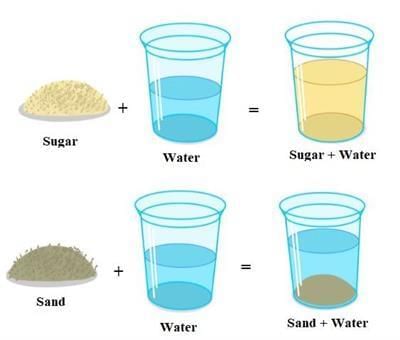
Page No. 30
Activity 4
Q. Which river looks healthy and why? What happens when too many plants grow (like a "green blanket") in a river?
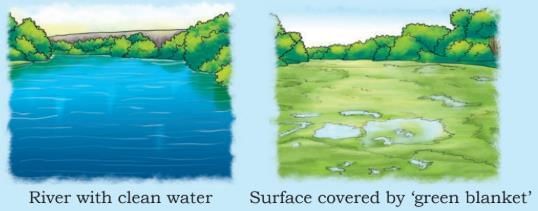 Answer: A river with clean, clear water and fish swimming is healthy because living things can survive there.
Answer: A river with clean, clear water and fish swimming is healthy because living things can survive there.
- Too many plants use up oxygen in the water, making it hard for fish and other animals to breathe. It also blocks sunlight and makes water unsafe for humans.
Page No. 31
Write
Q. Three things you can do to protect the water bodies near you:
Answer: 1. Never throw plastic, garbage, or chemicals into drains or rivers.
2. Use eco-friendly cleaners and soaps to reduce pollution.
3. Join or start community clean-up efforts for local ponds, lakes, or streams.
Page No. 32
Activity 5
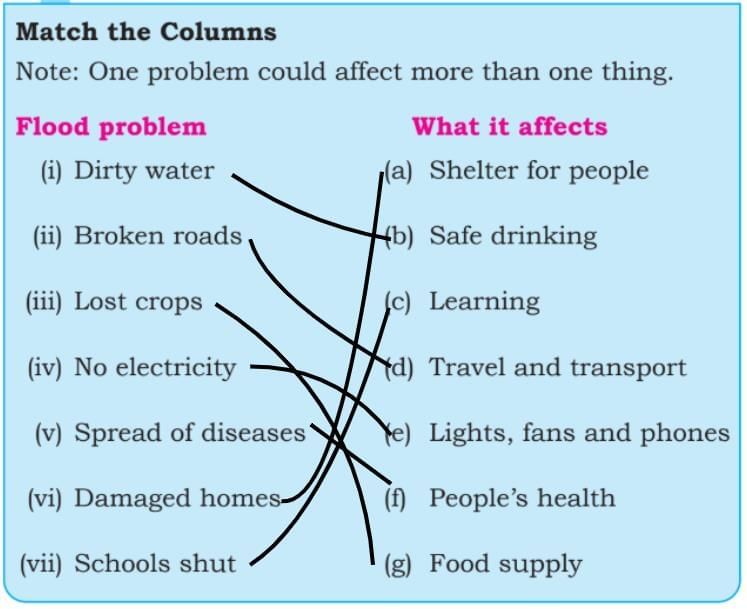
Page No. 33
Activity 6
In the time of floods, use these safety tips :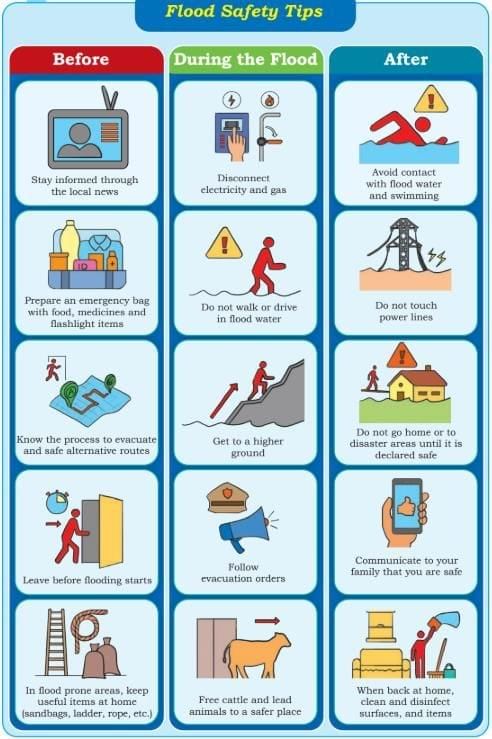
Page No. 34
Discuss
You are the village/city leader. What actions will you take
- Build and protect flood barriers and drainage to prevent flooding.
- Raise awareness and help the elderly and disabled during floods.
- Keep animals safe and sheltered.
- Regularly clean drains and riverbanks.
Page No. 35
Q1. What would you do if there was no water in your home for a day or a week?
Answer: For a day: Use stored water, ration carefully, maybe borrow from neighbours.
Q2. What if there was no water for a week? How would you bathe, drink, cook or clean? Where would you go to find water?
Answer: For a week: Go to public taps, tankers, or relatives. Use water only for essentials. Save rainwater if possible. May have to move if no water at all.
Page No. 37
LET US REFLECT
1. Find out which river(s) flow through your state.
(a) What are they used for?
(b) Are there any dams on them?
Answer: (a) Rivers in a state are commonly used for drinking water.
- They are also important for irrigating farms, which helps in growing crops.
- Fishing is another activity that relies on rivers for providing food.
- Sometimes, rivers are used for transportation, helping move goods and people.
- Additionally, rivers can play a role in industry, offering water for various processes.
(b) Many rivers have dams built on them to:
- Store water for use during the dry season.
- Assist with irrigation for farming.
- Generate electricity for homes and businesses.
- Supply water to nearby towns and cities.
2. Ask your grandparents or parents to share any story or festival related to rivers in your region and present it in the class.
Answer: Many places have unique festivals by rivers that honour the significance of water.
- For instance, the Godavari Pushkaram festival, which takes place near the Godavari River, is a time when people gather to bathe in the river's sacred waters.
- Your grandparents or older family members might tell you stories about how rivers were a part of their everyday lives.
- They may also share tales of important religious events that were connected to rivers.
3. Ask an elder in your family:
(a) What was the condition of rivers when you were a child?
(b) What has changed since then?
Answer: (a) Rivers were likely cleaner and fuller when more water was flowing through them.
People relied heavily on rivers for their daily needs.
(b) Rivers today may be more polluted with plastic waste, sewage, and chemicals.
Urbanisation and less care might have reduced water flow or cleanliness.
4. Why do you think people built houses and cities near rivers in the past? Are rivers still important today in the same way?
Answer: Rivers have historically provided essential resources such as drinking water, irrigation for farming, cleaning, and fishing.
- Because of these resources, many people chose to live near rivers for easy access to these vital needs.
- In the present day, rivers continue to be crucial for supplying water, aiding in agriculture, and supporting various forms of wildlife.
- However, it is now important to protect rivers from pollution and overuse to ensure they remain healthy and usable for future generations.
5. If you could create one new rule to protect rivers in your city or village, what would it be?
Answer: If I could create one rule to protect rivers, i would be to keep it clean by doing the following:
- No dumping of plastic or garbage in rivers.
- Planting more trees near riverbanks.
- Using eco-friendly products to reduce pollution.
- Fixing sewage and waste treatment systems to keep the river water clean.
6. Think about a time when you wasted water. What could you have done differently?
Answer: Things I could have done differently:
- Turning off the tap while brushing teeth.
- Using a bucket instead of a hose to water plants.
- Fixing a leaking tap.
- Reusing water after washing fruits or vegetables for watering plants.
7. Can you design a simple water filter using everyday materials? What would you include and why?
Answer: A simple water filter can have different layers, including sand, small stones, grated charcoal, and cloth.
- Sand is used to filter out dirt and tiny particles from the water.
- Charcoal helps to remove bad smells and some harmful chemicals.
- Small stones provide support for the other layers of the filter.
- Cloth acts as a barrier to catch bigger particles before the water passes through.
- Together, these materials work to make dirty water cleaner and safer for use.
8. Imagine you are planning a new city near a river. What steps would you take to:
(a) Keep the river clean
(b) Prevent floods during heavy rains
(c) Ensure there is always enough water for everyone, even during summer
Answer: (a) Keep the river clean
- Build proper sewage and waste treatment plants.
- Prevent the dumping of garbage in rivers and other places.
- Plant trees along riverbanks to help protect the environment.
- Create awareness programs to educate people about saving rivers.
(b) Prevent floods during heavy rains
- Planting trees helps absorb rainwater, which is beneficial for the environment.
- It's important to build safe flood barriers to protect areas from flooding.
- Avoid constructing homes too close to rivers to reduce the risk of flood damage.
- Creating soak pits and ponds can effectively soak up excess rainwater.
(c) Ensure there is always enough water for everyone, even during summer
- Collect rainwater using harvesting systems.
- Use water wisely to avoid wasting it.
- Build dams and reservoirs for storing water.
- Recycle water for use in gardens and farming.
|
14 videos|234 docs|10 tests
|
FAQs on Journey of a River NCERT Solutions - Our Wondrous World Class 5 - New NCERT
| 1. What are the main causes of river flooding? |  |
| 2. How do floods affect the environment and communities? |  |
| 3. What measures can be taken to prevent river flooding? |  |
| 4. What happens to rivers when they run dry? |  |
| 5. How does climate change impact river systems? |  |
















